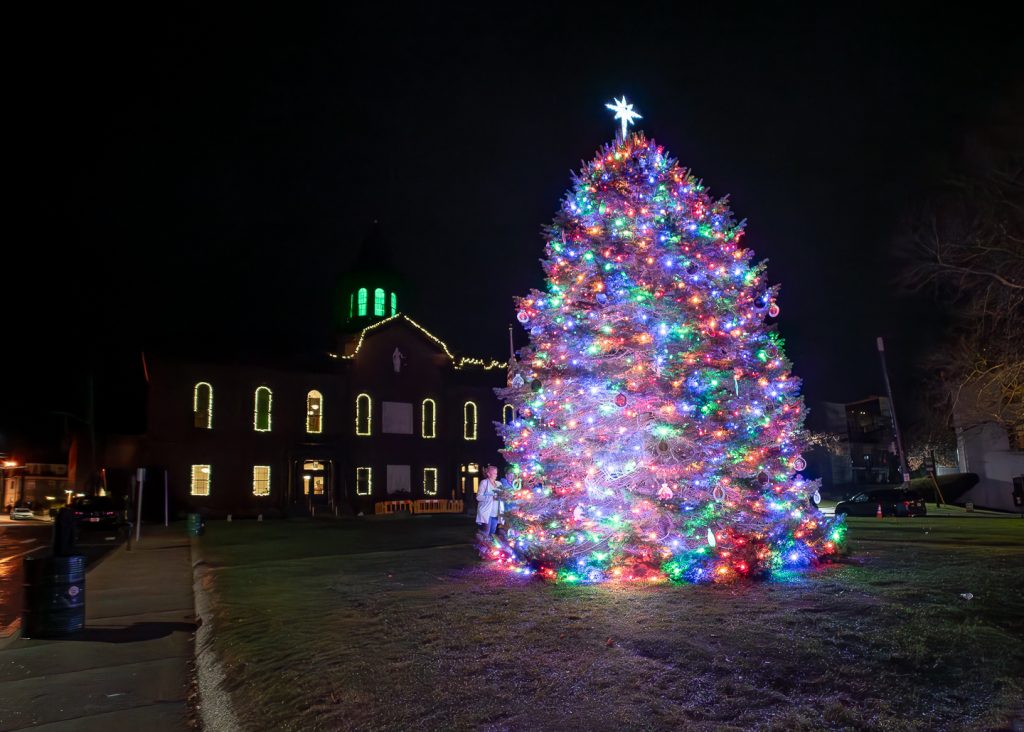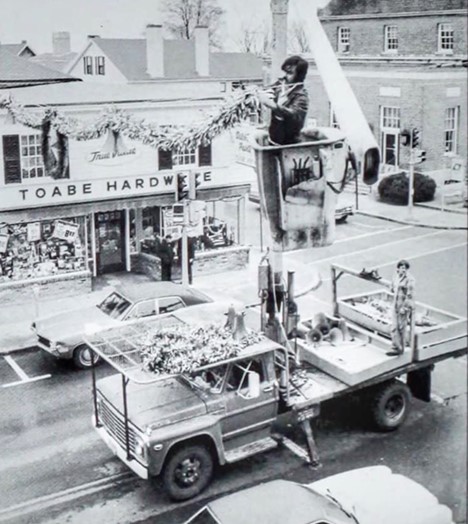Plymouth’s Communitree is up and lit for the holidays. The tree, after its latest move, now stands in front of town hall. This is the tree’s third location in our downtown core….or is it?
Finding the towns’ records of public holiday celebrations is not an easy task. Until quite recently, there are few written descriptions of Christmas throughout our 400-year history.
The earliest depictions of Christmas in Plymouth are grim. From Mourt’s Relation: A Journal of the Pilgrims at Plymouth, the December 1620 entry – the very first winter for the new settlers – reads: “Monday, the 25th day, we went on shore, some to fell timber, some to saw, some to rive, and some to carry, so no man rested all that day.”
It’s important to remember the Pilgrims did not believe in the holiday and, for them, it was not a day to celebrate. But there were others on the Mayflower, and some of them, as well as the sailors, were members of the Church of England. Christmas, for them, was supposed to be a day for rest and celebration. Still, given that they were in a harsh foreign place facing winter, I can understand the day passing with little fanfare.
The following year was worse. In 1621, additional settlers had arrived in Plymouth and not all of them were adherents of the Pilgrim Fathers’ beliefs. When Christmas arrived many assumed that Christmas in the New World would be the same as it had been in England. They were surprised to find it was not. Governor Bradford, writing in Of Plimoth Plantation, marks the day with this passage:“On the day called Christmas day, the Gov called them out to work, (as was used,) but the most of this new-company excused themselves and said it went against their consciences to work on that day. So the Gov told them that if they made it matter of conscience, he would spare them till they were better informed.”
Ouch…a scolding! (Even worse, he writes about himself in the third person!)
But Bradford was just getting started. Later in the day, public celebrations spilled into the street. Bradford notes: “So he led-away the rest and left them; but when they came home at noon from their work, he found them in the street at play, openly; some pitching the barr and some at stoole-ball, and such like sports.”
Since the scolding wasn’t sufficient, Bradford took more drastic action. “So he went to them, and took away their implements, and told them that was against his conscience, that they should play and others work. If they made the keeping of it matter of devotion, let them keep their houses, but there should be no gaming or revelling in the streets.” He took their toys away! The Grinch was alive and well in Plymouth. Bradford notes that public celebrations never occurred again on his watch.
As Puritanism took hold in Massachusetts, the celebration of Christmas became illegal. Christmas was officially outlawed in Massachusetts from 1659 to 1681. But even after 1681, there is little indication that Christmas was publicly celebrated.
I looked at one of my prized books, Plymouth Town Records 1743 to 1783, which lists elected officials, town expenditures, and construction projects. There is not a single entry that mentions Christmas or expenditures for the holiday.
Looking forward in time, I reached for another historic resource: William T. Davis’ Memories of an Octogenarian from 1906. Davis was born in Plymouth in 1822 and died in 1907. There is only one passage regarding Christmas. Davis writes: “Christmas during my day came and went without observation or notice. It was not a holiday, presents were not exchanged, schools were kept, and the wish for a Merry Christmas was never heard.”

Even well into the 20th century, Christmas was barely acknowledged here. The earliest record that historian Donna Curtin found dates from before World War I. Here’s an Old Colony Memorial notation from December 25, 1914: “Plymouth’s first community Christmas tree electrically lighted with colored lights on lawn in front of Court House.”
Conor Anderson, our town archivist, found a record from 1927. Harkening back to our Bah-Humbug sentiment, the Selectmen’s meeting notes on November 18 that year state: “George C. Marsden, representing the Directors of the Plymouth Chamber of Commerce, made request for permission to carry out plans for observance of Forefathers’ Day and a Community Christmas Tree, expenses of both to be paid from the appropriation for July 4th and Forefathers’ Day. The Board was not willing to approve of any expenditure from this appropriation for the Christmas Tree.”
The Selectmen’s mood would change on November 19, 1931. Perhaps the Depression was weighing on their minds and they wanted something to brighten local spirits. “On request from Mr. Frank Mitchell representing the Plymouth Merchants Association,” the minutes read, “it was agreed to allow a Christmas tree to be placed in Shirley Square near the flashing traffic beacon, as a part of the holiday lighting of Main and Court streets.” We can presume that other decorations besides the tree lined Main Street and Court Street as well, perhaps paid for by store owners.
To better understand how Plymouth went on to celebrate Christmas, I reached out to three folks with a wealth of information: Colleen Sullivan Taormina, David Malaguti, and Sheila Kaiser. Colleen’s Dad, Gerald Sullivan, extensively photographed Plymouth during his lifetime. She shared with me a photo taken of the Courthouse in the 1940s. The photo showed Santa’s village on the Courthouse Green. David remembers Main Street lined with trees in green lattice boxes in the early 1950’s.
Sheila is the founder of the Facebook group, Plymouth Remembering When. Because of her, the Facebook photo collection is beginning to rival the photo collection at Pilgrim Hall. It has become another go-to location for information.
In the “Plymouth Remembering When” collection are numerous photos of my earliest memory of Plymouth’s public holiday displays. I remember the garlands that stretched across Main Street and Court Street downtown, along with those on Court Street in North Plymouth. To me, as a child, this display heralded the beginning of the holiday season. The garlands began their life in Plymouth in the mid 1950’s and lasted until an early January blizzard in 1978 destroyed them. They were replaced by decorations affixed to light poles, but those disappeared a few years later.
About this time, the tree lighting in Shirley Square appeared on the scene. The date is unclear, but the tradition began in the late 1970’s after the renovation of the square. The Shirley Square tree was joined in time by trees in Cedarville, Manomet and North Plymouth. The Manomet tree has bounced around to different locations in the village. Not to be outdone, the downtown Plymouth tree has moved several times, from Shirley Square to Town Square, to its present location in front of Town Hall.
I’m sure I have missed a few events. Maybe, by this time next year, my own research and that of others will turn up some additional information. If you remember a public celebration of Christmas, Hanukkah, or winter holiday event, please let me know. Together we can write another piece of Plymouth’s history.
Architect Bill Fornaciari, a lifelong resident of Plymouth, is the owner of BF Architects in Plymouth. His firm specializes in residential work and historic preservation. Have a question or idea for this column? Email Bill at billfornaciari@gmail.com.

